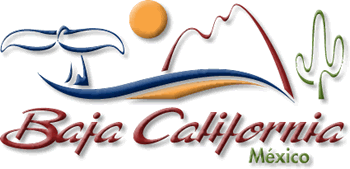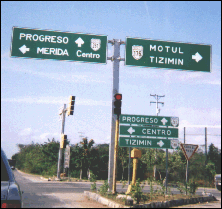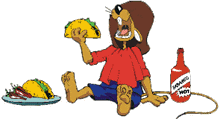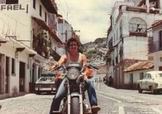
FAQ Topics: Here are the answers to commonly asked questions. Use this to help you in your decision-making. If you have any question to ask, you can click at the bottom.

Last revision: October 12, 2004
1. Is helmet a law mandatory in Mexico?
There is no helmet law in Mexico. However I would always want to take my helmet with me just in case. I think it is your personal decision to make - freedom of taking the risks, or prevention of harms. Adults are capable of making responsible choices.
2. Are the driving regulations similar in Mexico to our country?
Driving regulations in Mexico are pretty much the same as they are in Canada or the U.S. so they are probably similar to the regulations from where you reside. You obviously need a driver's license to drive a vehicle in Mexico and beyond that use common sense.
3. Is it easy to follow road signs since I can not read Spanish?
Everyone will have a map of Baja California when you travel in Mexico. You could get it at any AAA office. You must know your destination for the day to which city you are expected to arrive. So this is a typical direction sign in the Yucatan just outside Merida. Notice "Centro" on the top sign indicating that is the way to the center of Merida.

4. Is there any authorized H-D service along the way?
I doubt it but I understand there is a H-D store in Cabo San Lucas that sells attires. Mexico is a remote land where population is far and few. Mountains and plains are seen more but it is magificient ride.through. I would highly recommend that you have your bike serviced before you hit the road to Mexico for the sake of peace mind and bring your tools. Harley-Davidson Store in Mexcio
5. Where will I leave my trailer and car before I hit the road to Mexicoi if I decide to haul my bike to Riverside?
I will seek someone from Riverside who will be happy to find locations for your stuffs to store at the RV storage near Riverside.
6. Is there any plan to have a sum of memorable pins for us to buy?
There is no plan at this time for memorable pins but there is a fellow who would be happy to prepare pins. It should read like this Deaf Bikers of America - Baja California - 2007
7. Would we have a backup service vehicle along the way?
It would be a good idea to have a backup vehicle. As a matter of fact, this trip is not restricted to the bikers only. Anyone who is interested in participating in this tour may join us. We could make arrangement with the driver to have a hitch that can haul the disabled bike. Tentatively there is a fellow who could make something that can haul the bike with front wheel.
8. How would we know if there are problems for some bikers in the back of the group?
There are two-way radios that can be bought at the Radio Shack. They are good for up to a two-mile range. The tour leader will be assigned one for the front of group and one for the back of the group. We would not have to be in close group at all time. The two-way radios can be vibrated.. Cool! Isn't it?

9. How is about the Montezuma's Curse?
Travelerís diarrhea, has ruined many a vacation, especially to high-risk destinations such as Mexico and India. It is the most common infectious disease experienced by travelers, affecting almost 50% of individuals traveling. Never take food/drinks from strangers and food stands. The disease is transmitted and spread by water or food contaminated with causative organisms. Itís always best to drink bottled beverages, avoid foods that are washed in water, and eat only whatís been freshly cooked and is served piping hot. Of remote place, the ice cubes are made in the store where you order for some drinks, which the water used is very likely not purified.
Kaopectate is concentrated anti-diarrheal that could be bought from over the counter but Xifaxan is safer than Cipro and more effective than over-the-counter medications, but travelers should remain cautious and proactive to avoid getting sick. Pepto Bismol is also helpful, as are Lomotil and Imodium A-D.
Changing the approach to treating the common ailment is an antibiotic thatís newly approved in the U.S., but one thatís been prescribed in Europe for years. Rifaximin was given the official OK by the FDA this past spring, and as of August itíll be sold under the name Xifaxan.
If youíre going to a country thatís known as a T.D. or diarrhea risk, your doctor might consider prescribing Xifaxan before you leave. Some studies show that the drug could be taken in small doses every day as a preventive measure, before you ever get sick (which is far less torturous than trying to treat T.D. after the fact).

Moral of this information is drink more liqueur in Mexico. It is probably better at killing bacteria than beer. Some bikers seem to be concerned more about their bike engine than their health. The more chance you will have in Mexico is your health problem.

10. What can we do with the wet towel before moving on with the tour?
It would be handy to have a face cloth after taking a shower, use it to wipe off the excessive water before drying with a bigger towel. That way it would minimize the wet towel. Before leaving for the tour, tie your face cloth somewhere on your bike to dry.
11. Is it safe to travel in Mexico? I understand that there are no shoulders on the road.
Safety is always our number one for a pleasant tour. The completion of the paved Transpeninsular Highway (Mexico Highway 1) in late 1973 marked the beginning of a new era for Baja California. That was when I motorcycled in Mexico. Yes there are some roads without shoulders just like we have none in some parts of the U.S. My main concerns are when we wish to exit immediately to view the sights of interest points or for some beers, we need not to move suddenly without giving the bikers behind you ample time to switch changes or to react to the immediate movement. We also should not try to travel at night. No point in gambling due to poor visibility on the roads, unexpected wild animals and/or road hazards.
12. What if, we get lost along the way?
Itinerary will be provided for each rider so it would be impossible for one to get lost in Baja California because there is only one highway all the way from the border to the end of southern pensinsula.. Also every city is small. It is easy to find one another along the way and in the city. Bright color stickers will be placed on the front of your handlebar for easy identification. It will be a convenient way to locate one another when we parked somewhere on the street. Most gas stations are located at the end of city. Whether you will be up the front traveling or behind the group, we will always stop at the first gas station. That way it would be easier to regroup.
13. Would Puerto Vallarta be our farthest city on our itineary?
No, we have two tour plans. We will travel together throughout the Baja California. When we get off the ferry at Puerto Vallarta which is on the mainland of Mexico. We will stay overnight in that city. The next day Group A will move on to Acapulco. Group B will travel north. Group B has a two-week tour plan. Group A has three-week tour plan. In order to reach Acapulco it requires another week. May we hear your comment whether we should have two tour plans or one?
14. Are there plenty of gas stations? - What about quality of gasoline?
Most cities have gas stations. For Sportster with small gas tank would easily make it for the entire trip with an average of 100 miles or less. It can stop at each city with an exception of Sonora near the U.S. border on Mexico Route 2. (200 miles apart between the gas stations). We should not be concerned with the quality of gasoline. Off the point, Mexico do produce computers, Volkwagens, and the like and no one is concerned about quality.
The gasoline station market in Mexico is a monopoly, run by Petroleos Mexicanos (PEMEX). The company owns all gasoline stations, but, since 1992, does not directly operate all sites, with most now operated under franchise. The company controls the number of franchises operated and the standards for each site. PEMEX is the only gasoline brand available in Mexico. Road travel is extremely important in Mexico, and is the only option available to most people.
Nova
Novas, is the lowest grade of gasoline and also the most common. It is sold out of Blue dispensing pumps, and is popular with Mexican drivers because of it's price (usually a few pennies less per gallon than higher grades). Most heavily laden RV's cannot use Nova, becuase it's octane level is far less than even the lowest grade of US gasoline, and it's use causes severe knocking and piston damage. Contrary to popular opinion, Nova does not contain significant amounts of tetraethyl-lead.
Environmental pressures in the USA caused the lead additive market to dry up early in the 1980's, and subsequently, lead was phased out of Nova gasoline in the late 1980's. I use Nova only when I cannot avoid it. Curiously, running the fuel through a engine does not produce immediate results. It's only after a hundred miles or so, that the full effects of it's low octane begins to cause pre-ignition and detonation.
Magna Sin
This mid-grade fuel is sold from a bright green pump, and is Mexico's most popular unleaded gasoline. It's octane level is somewhere around 86, and is superior to the silver pump "Extra" which it replaced in 1990. Most vehicles will run acceptably on "Magna" (as it's popularly called in Mexico). However, some very heavily laden motor homes and tow vehicles can find themselves in a position where Magna Sin, is just "border-line" in preventing knocking and pinging. These vehicles will have to have their ignition timing adjusted to prevent engine damage.
Premium
Mexico's newest gasoline, is also it's best effort to date. Unfortunately Premium gasoline is found only in larger towns and cities, and will slowly migrate outwards to medium size towns. Premium seems to have an octane rating that's higher than US regular unleaded gasoline. The superiority in octane and performance over Magna Sin, makes seeking out and filling your tank with this fuel a wise choice, when availability permits. Premium is unleaded, and like Nova, and Magna Sin, Premium, does not seem to contain the Additive "MTBE" found in California fuels.
15. Do I need an insurance for my motorcycle?
Yes definitely, for you as the serious adventurer, a motorcycle journey through Mexico can be the ultimate motorcycle experience. They offer liability insurance for street legal motorcycles as well as full coverage for certain motorcycle makes and models. Get the insurance for your trip to Mexico early so as to avoid the rushes! Riders who wait usually find it very time consuming. Contact them for details
16. Is it cheap to travel in Mexico?
It is difficult to maintain a cost of living database because the costs keep changing and prices vary between seasons, areas and stores. Generally, it is cheaper to live in Mexico for most lifestyles and you.
Fresh fruit, vegetables, poultry, meat, bakery items, buses, insurance, health care, personal services, car repairs, and property taxes are all cheaper, and in some cases much cheaper in Mexico. Cosmetics, toiletries, imported foods, some clothing, and gasoline are generally more expensive.
Restaurant meals can vary from much cheaper to even more expensive than in the US or Canada; it depends on where the restaurant is located and their customer base. People who live in Mexico usually find a few restaurants where they can eat very inexpensively.
17. Have you ever been to Mexico yourself?
I think that this picture is evident that I was there on my 400cc Hawk Honda. This picture was taken in Taxco, Mexico a couple of hours off Acapulco on the mountainside. It was when I traveled alone to Acapulco via Baja California in 1979. After that I went three more times. I have been around the world, but I still return to Mexico for real riding. There's nothing like it anywhere in the world. You've got to believe this, man.

18. What do I need to bring along?
19. May I have further information about Mexico through the Internet?
20. Do we sleep in a tent for our entire trip?
No, it is not necessary to say this, but we will sleep at most RV parks and beaches. Camping on the beach is one of the great attractions for Baja travelers. You may find yourself on one of the few beaches with improvements or in one of the RV parks situated on a beach. In some cities we would stop do have some reasonable motels. It would be up to you when you are in a mood for more comfort. We can meet at a specific place after our breakfast before we move on with our trip. If four of us, the bikers, decide to chip a share, it would not cost you as much as you would pay in the U.S. That would be chicken feed!
21. When would this trip take place? I would like to know exact date.
Exact date has not been definited yet, but it should be in July 2007. We will know by August 8-14, 2005 at the 65th Annual Sturgis Motorcycle Rally.
22. Would we make time to visit their Tequila Distilleries? If so where?
Yes, we would stop by the Tequila Distilleries only if we go to Acapulco. On the way back to home, there is a town called Tequila near Guadalajara. Jose Cuervo and Sauza are the 2 major tequila producers. Both offer tours through their distilleries. The tours both begin with guides perfectly fluent in English and very well versed in the history of this liquor as well as its deep roots in the Mexican culture.


|








